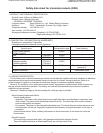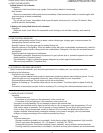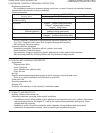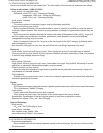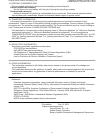
Product name: Lithium Ion Battery Cell Reference number: SDS-IBT-00010
Establishment / Revision: Dec.1 2008
3/5
8. EXPOSURE CONTROLS / PERSONAL PROTECTION
Engineering measures:
No engineering measure is necessary during normal use. In case of internal cell materials' leakage,
operate the local exhaust or improve ventilation.
Control parameters
Common chemical name /
ACGIH (2002)
General name
TLV-TWA BEI
Lithium metal oxidate
(Li(Mn-Co-Ni)O
2
)
0.02mg/m
3
(as cobalt) -
Aluminum 10mg/m
3
(metal coarse particulate)
5mg/m
3
(inflammable powder)
5mg/m
3
(weld fume)
-
Carbon (Natural graphite)
(Artificial graphite)
2mg/m
3
(inhalant coarse particulate)
-
Copper 0.2mg/m
3
(fume)
1.0mg/m
3
(a coarse particulate, Mist)
-
Organic electrolyte - -
ACGIH: American Conference of Governmental Industrial Hygienists, Inc.
TLV-TWA: Threshold Limit Value-Time Weighted Average concentration
BEI: Biological Exposure Indices
Personal protective equipment
Respiratory protection: Respirator with air cylinder, dust mask
Hand protection: Protective gloves
Eye protection: Goggle or protective glasses designed to protect against liquid splashes
Skin and body protection: Working clothes with long sleeve and long trousers
9. PHYSICAL AND CHEMICAL PROPERTIES
Appearance
Physical state: Solid
Form: Cylindrical
Color: Metallic color (without tube)
Odor: No odor
pH: NA
Specific temperatures/temperature ranges at which changes in physical state occur:
There is no useful information for the product as a mixture.
Flash point: NA
Explosion properties: NA
Density: NA
Solubility ,with indication of the solvent(s): Insoluble in water
10. STABILITY AND REACTIVITY
Stability: Stable under normal use
Hazardous reactions occurring under specific conditions
Conditions to avoid: When a battery cell is exposed to an external short-circuit, crushes, deformation,
high temperature above 100 degree C, it will be the cause of heat generation and ignition. Direct
sunlight and high humidity.
Materials to avoid: Conductive materials, water, seawater, strong oxidizers and strong acids.
Hazardous decomposition products: Acrid or harmful gas is emitted during fire.



